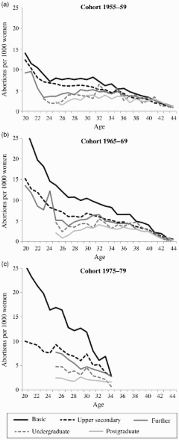The association between education and induced abortion for three cohorts of adults in Finland
- PMID: 26449684
- PMCID: PMC4950447
- DOI: 10.1080/00324728.2015.1083608
The association between education and induced abortion for three cohorts of adults in Finland
Abstract
This paper explores whether the likelihood of abortion by education changed over time in Finland, where comprehensive family planning services and sexuality education have been available since the early 1970s. This subject has not previously been studied longitudinally with comprehensive and reliable data. A unique longitudinal set of register data of more than 250,000 women aged 20-49 born in 1955-59, 1965-69, and 1975-79 was analysed, using descriptive statistics, concentration curves, and discrete-time event-history models. Women with basic education had a higher likelihood of abortion than others and the association grew stronger for later cohorts. Selection into education may explain this phenomenon: although it was fairly common to have only basic education in the 1955-59 cohort, it became increasingly unusual over time. Thus, even though family planning services were easily available, socio-economic differences in the likelihood of abortion remained.
Keywords: Finland; event-history analysis; induced abortion; register data; reproductive health.
Figures





Similar articles
-
EDUCATIONAL INEQUALITIES IN REPEAT ABORTION: A LONGITUDINAL REGISTER STUDY IN FINLAND 1975-2010.J Biosoc Sci. 2016 Nov;48(6):820-32. doi: 10.1017/S002193201600016X. Epub 2016 Apr 29. J Biosoc Sci. 2016. PMID: 27128981
-
The impact of women's employment and education on contraceptive use and abortion in Kinshasa, Zaire.Stud Fam Plann. 1994 Mar-Apr;25(2):96-110. Stud Fam Plann. 1994. PMID: 8059449
-
Declining induced abortion rate in Finland: data quality of the Finnish abortion register.Int J Epidemiol. 1996 Apr;25(2):376-80. doi: 10.1093/ije/25.2.376. Int J Epidemiol. 1996. PMID: 9119563
-
Induced abortions by woman's country of origin in Finland 2001-2014.Scand J Public Health. 2020 Feb;48(1):88-95. doi: 10.1177/1403494818812640. Epub 2018 Nov 29. Scand J Public Health. 2020. PMID: 30486736
-
A review of induced abortion rates in England and Wales, 1969-1994.Br J Fam Plann. 1998 Jan;23(4):120-6. Br J Fam Plann. 1998. PMID: 9882765 Review.
Cited by
-
Association between the use of free-of-charge intrauterine devices and a history of induced abortion: a retrospective study.BMC Womens Health. 2019 Oct 18;19(1):120. doi: 10.1186/s12905-019-0821-3. BMC Womens Health. 2019. PMID: 31627718 Free PMC article.
-
Educational Attainment and Pregnancy Outcomes: A Danish Register-Based Study of the Influence of Childhood Social Disadvantage on Later Socioeconomic Disparities in Induced Abortion, Spontaneous Abortion, Stillbirth and Preterm Delivery.Matern Child Health J. 2019 Jun;23(6):839-846. doi: 10.1007/s10995-018-02704-1. Matern Child Health J. 2019. PMID: 30612294
-
Explainable artificial intelligence models for predicting pregnancy termination among reproductive-aged women in six east African countries: machine learning approach.BMC Pregnancy Childbirth. 2024 Sep 16;24(1):600. doi: 10.1186/s12884-024-06773-9. BMC Pregnancy Childbirth. 2024. PMID: 39285277 Free PMC article.
-
Births and induced abortions among women of Russian, Somali and Kurdish origin, and the general population in Finland -comparison of self-reported and register data.BMC Pregnancy Childbirth. 2018 Jul 10;18(1):296. doi: 10.1186/s12884-018-1931-x. BMC Pregnancy Childbirth. 2018. PMID: 29991354 Free PMC article.
-
What has women's reproductive health decision-making capacity and other factors got to do with pregnancy termination in sub-Saharan Africa? evidence from 27 cross-sectional surveys.PLoS One. 2020 Jul 23;15(7):e0235329. doi: 10.1371/journal.pone.0235329. eCollection 2020. PLoS One. 2020. PMID: 32702035 Free PMC article.
References
-
- Andersson Gunnar, Rønsen Marit, Knudsen Lisbeth B., Lappegård Trude, Neyer Gerda, Skrede Kari, Teschner Kathrin, Vikat Andres. Cohort fertility patterns in the Nordic countries. Demographic Research. 2009;20:313–352. doi: 10.4054/DemRes.2009.20.14. - DOI
-
- Bankole Akinrinola, Singh Susheela, Haas Taylor. Reasons why women have induced abortions: evidence from 27 countries. International Family Planning Perspectives. 1998;24(3):117–152. doi: 10.2307/3038208. - DOI
-
- Becker Gary S. A Treatise on the Family. Enlarged ed. Cambridge, Mass, London: Harvard University Press; 1991.
-
- Bongaarts John. A framework for analyzing the proximate determinants of fertility. Population and Development Review. 1978;4(1):105–132. doi: 10.2307/1972149. - DOI
Publication types
MeSH terms
LinkOut - more resources
Full Text Sources
Other Literature Sources
Medical
